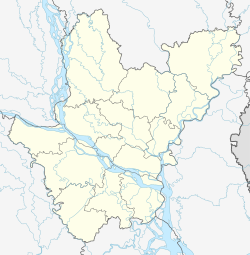Siddhirganj | |
|---|---|
City | |
| Coordinates: 23°41′N90°31′E / 23.683°N 90.517°E | |
| Country | |
| Division | Dhaka Division |
| District | Narayanganj District |
| Government | |
| • Type | Narayanganj City Corporation |
| Area | |
• Total | 22.71 km2 (8.77 sq mi) |
| Population | |
• Total | 256,760 |
Siddhirganj, is one of the oldest industrial cities of Bangladesh. It is located in the bank of Shitalakshya River, Narayanganj. The Siddhirganj Industrial Zone has more than 15 thousand factories and industrial establishments. Adamjee Jute Mills was established in Siddhirganj in 1951 and was once the largest jute mill in the world. This city is also one of the largest exporter in the country. In 2018–2019, the Adamjee export processing zone [1] in Siddhirganj [2] exported more than 4 billion US dollars' worth of goods. [3]

